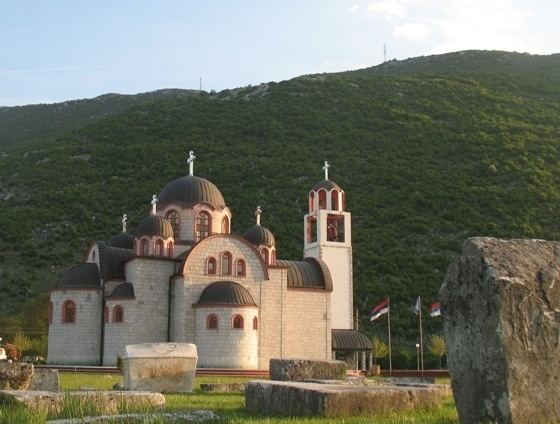Boroughs 21 (2008.) Area 326 km² Area code 59 | Time zone CET (UTC+1) Local time Thursday 10:46 AM | |
 | ||
Weather 19°C, Wind S at 10 km/h, 47% Humidity | ||
Ljubinje (Serbian Cyrillic: Љубиње) is a town and municipality in Republika Srpska, Bosnia and Herzegovina. It is situated in south-eastern part of Herzegovina region.
Contents
- Map of Ljubinje Bosnia and Herzegovina
- Early history
- Middle Ages
- Ottoman Occupation 14671878
- Austro Hungarian Occupation 18781918
- Church of the Nativity of the Virgin
- Church of the Nativity of the Lord Jesus Christ
- Demographics
- Notable residents
- References
Map of Ljubinje, Bosnia and Herzegovina
Early history
In the antique period, a road ran from Narona to Epidaurum via Pardua, present day village Gradac, near Ljubinje. The remains of a Roman settlement have been identified near Ljubinje. No systematic expert investigations have ever been conducted in the area.
Middle Ages
In the early mediaeval period the area of present-day Ljubinje municipality belonged to the large early mediaeval župa (county) of Popovo, constituting the northernmost part of Popovo county, bordering with the counties of Dubrave and Dabar. Politically, the area belonged to the Hum district, ruled from the 12th to almost the first half of the 14th century, with minor interruptions, by the Nemanjić's. From 1324 to 1326 this part of Hum was occupied by Bosnia's Ban Stjepan II Kotromanić, whose heir Tvrtko I had by 1373 extended the borders of the Bosnian state southwards to take in the whole of Hum. Tvrtko's reign saw the rise to power of the Kosača family, of whom Vlatko Vuković had already by that time begun to rule much of Hum;during Sandalj Hranić's (1392-1435)and Herceg Stjepan Vukčić Kosača's (1435-1466) time and that of the latters sons, until1482, Hum was entirely governed by the family.
Ottoman Occupation 1467–1878
The Ottomans occupied the area around Ljubinje between 1465 and 1467, and the census of the Bosnian sandžak for 1468/69 already included the nahija of Ljubinje.
Austro-Hungarian Occupation (1878–1918)
Under article 29 of the Treaty of Berlin of 1878, Austria-Hungary received special rights in the Ottoman Empire's provinces of Bosnia-Herzegovina and the Sanjak of Novi Pazar. On 14 August 1878, Austro-Hungarian army marched in Ljubinje, ending Ottoman rule in the region. On 6 October 1908, Emperor Franz Joseph announced to the people of Bosnia-Herzegovina his intention to give them an autonomous and constitutional regime and the provinces were annexed. Bosnian annexation was not countenanced by the Treaty of Berlin and set off a flurry of diplomatic protests and discussions. Ljubinje remained part of the Austro-Hungarian Empire until the liberation at the end of World War I, when the Serbian army marched into Ljubinje.
Church of the Nativity of the Virgin
The Serbian Orthodox church of the Nativity of the Virgin in Ljubinje, was built between in 1867 (as recorded by the inscription incised on a plaque above the entrance to the church). The Church belongs to the type of Herzegovina single-nave stone-built church with semicircular apse and stone belltower of the type known as "na preslicu", perched over the main entrance facade. A belltower na preslicu with three bells, made of finely finished limestone blocks, tops the west wall of the church. Belltowers of this form are one of the main characteristics of churches of this type in Herzegovina. The church is roofed with industrial tiles. Only the ends of the roof panes (by the belltower and the apse respectively) are clad with sheet copper. The apse is also clad with sheet copper. The nave is separated from the altar space by an iconostasis partition. The iconostasis of the church of the Nativity of the Most Holy Virgin in Ljubinje was installed in the early 20th century. The artist who painted the icons remains unidentified. The frame of the iconostasis is wooden, and to it are attached the icons, paintings on canvas with various scenes. The church contains a copy of the Gospels dating from 1793, in a metal cover with two metal clasps to the side, donated from Russia along with double-sided processional icon, made of copper, by Zorka Radonjić (1901). The centre of one side of the processional icon is occupied by an embossed and engraved scene of the Nativity of Christ, and the other by the Evangelist Luke, also embossed and engraved.
To the north, east and west, the church is surrounded by an Orthodox cemetery in active use, and Necropolis with stećak tombstones. About 20 metres to the north of the church is a mausoleum in memory of World War II victims of fascist terror.
The Commission to Preserve National Monuments in 2005 issued a decision to add the architectural ensemble of the Church of the Nativity of the Virgin in Ljubinje to the List of National Monuments.
Church of the Nativity of the Lord Jesus Christ
The Serbian Orthodox Church of the Nativity of the Lord Jesus Christ in Ljubinje was designed by Serbian architect Ljubiša Folić. Church was named after the Nativity of Christ for the fact that its construction started in 2000, an important year in Christianity that actually commemorates its most important event and the reason why it exists in the first place. Completion of the work and consecration of the new Orthodox Cathedral was solemnly celebrated on 21 September 2004, on patron Saint’s Day of Ljubinje municipality (The feast day of the Nativity of the Most Holy Theotokos ). The Holy Hierarchal Liturgy was served by episcope of Zahumlje, Herzegovina and the Littoral Grigorije.
Demographics
According to the 1910 census, the absolute majority in Ljubinje municipality were Orthodox Christians (58.40%).
In the town of Ljubinje:
By settlements, in 1991
